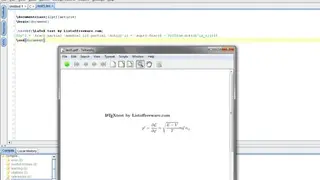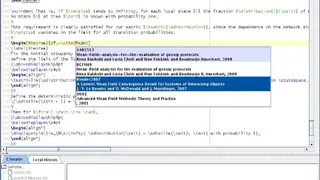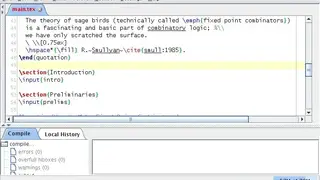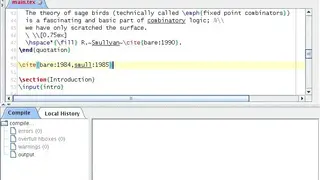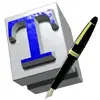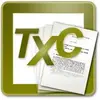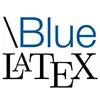
JLatexEditor
JLatexEditor is a cross-platform open-source LaTeX editor that provides you with a unique development environment. The tool is highly configurable and can be integrated with many tools that you might need to write the document. The editor is built for Linux ad macOS. The UI is pretty intuitive as the editing area comprises tab support, so you can work on more projects at the same time. There is also a line numbering to keep the code track and syntax highlighter for easy function identification.
A navigation panel is also there on the side that helps you restructure the sentence, navigate through elements, and access the content-rich library of symbols to insert your code. The program supports multiple LaTeX file formats like DEF, TEX, and BIB, but you can also build projects under PDF or DVI formats. A search option is also there to find a particular string or text. All in all, JLatexEditor is a great tool that you can consider among its alternatives.
JLatexEditor Alternatives
#1 TeXworks
TeXworks is a simple working environment for authoring Tex documents, including ConTeXt, LaTeX, and XeTeX. It provides an integrated and easy-to sue environment specifically on the Linux platform and features a clean interface for new and advanced users. It consists of a built-in PDF viewer that uses popular library and has an auto-refresh capability. Additionally, it supports SyncTeX that lets you sync the PDF viewer position with the source.
The editor is Unicode, providing you with quick access settings for the encoding style. It also offers the possibility to jump to a specific line of the text. Out of many practical handfuls of tools, the search function is one of them. This allows you to find specific content in your text and let you replace text or highlight specific sections. Other features are changing the font style, remove or add comments, and toggle line numbers.
#2 Table Generator
Table Generator is an online LaTeX text editor that lets you edit or generate the tables with desired settings. You can adjust the properties from the right side of the interface after clicking on the cell of the table. As you take over the mouse cursor on the fields, you can see the current table dimensions highlighted. The website has a very useful feature, i.e. it can not only delete all table tags automatically in the source code, but it also converts tables to structures blocks. After that, it positions the cells in the desired format using the .css style.
#3 VimTeX
VimTeX is a modern Vim and neovim filetype plugin for LaTeX files. Vimtex supports completion for citations, labels for figures, equations, tables, sections, etc., commands, environments, packages, and document classes, and more. It can also work with multiple completion engines like Complete, deplete, ncm2. A highlighting feature of this tool is the auto-completion via auto-completion engine like deoplete that is crucial for fast editing and improves our efficiency dramatically. After configuring vimtex to use deoplete, you should be able to use the snippet provided by Ultisnips.
#4 TeXnicCenter
TeXnicCenter is an open-source IDE for LaTeX typesetting language. It lets you type documents in LaTeX and compile them in PDF, DVI, or PS. It provides access to a menu of precoded elements and environments. As a substitute for having to use several different tools like an editor for writing the document and the LaTeX command-line tools for building them, TeXnicCenter provides all necessary tools from within its powerful user interface. The powerful LaTeX editor, including syntax highlighting, auto-completion, real-time spell checking, dynamic word wrapping, and a lot more, makes it a joy to enter and maintain your texts.
Tons of predefined text snippets and LaTeX commands available from the menus and the toolbars make it needless to search the LaTeX reference. Some other notable features include LaTeX code snippets, tabbed MDI window, customizable toolbar, integrative tools, syntax highlighting, auto-completion, parenthesis matching, dynamic word mapping, spelling checker, forward inverse search, and much more.
#5 Texpad
Texpad is an app that allows you to edit LaTeX and is designed for straightforward use. You can navigate, edit, and typeset projects of any size. Texpad scans if you open the toot file of LaTeX. You can also open any referenced file, extract the document structure and configure it according to your need. The table of contents and other information extracted from complex documents are presented in a way that’s easy to navigate. All sub-files, images, and other files included in your documents are listed for a quick overview.
Additionally, you can search the entire document at once, including sub-files when included. A PDF viewer is built into the app and custom-designed to render the LaTeX output. You can easily remember the incomplete sections by placing to-do tags in your document that you can jump from the sidebar. After compiling, the errors are parsed out of your LaTeX source and presented as a list. The full log is also shown. All in all, Texpad is a great app that you can consider among its alternatives.
#6 WinEdt
WinEdt is a versatile text editor available for Windows with a tendency towards the creation and compilation of LaTeX documents. You can use this tool as a frontend for compilers and typesetting systems like HTML, TeX, and NSIS. It lets you customize its own text highlighting schemes for various modes, and the spelling check functionality supports multi-language mode with dictionaries.
The program also supports auto-completion, code folding and seamlessly integrates with the latest accessories like MiKTeX, TeX Live, and SumatraPDF. Some highlighting features include multiple document interface, Unicode capabilities, right to left language support, chapters and sections that can be displayed in a collapsible menu, bibliographic entries and labels, configurable execution, access to mathematical symbols, and parsing of document compilation errors.
#7 Bakoma Tex
Bakoma Tex is an intuitive LaTeX editor that you can use for writing papers and the simultaneous learning of LaTeX. The tool dramatically simplifies the editing of complex formulas and tables. Besides this, you can also edit slides into the software. With its Centaur tool, editing the diagrams is much easier, even for beginners. Centaur is a classical text editor providing much more comfortable editing of TeX/LaTeX documents. It includes features like syntax highlighting, launching, TeX tools, spells checking, etc.
#8 TeXlipse
TeXlipse is a typesetting system that you can use for document preparation and publications. You can consider this tool as a plugin to enable Eclipse support for LaTeX projects. Some highlighting features of TeXlipse are code folding, content assist, table editor, F3 navigation, templates, spell checking, NibTeX and BibaTeX support, Bibsonomy integration, error annotations, line wrapping, BibTeX editing support, file, and document outline, build support, and integration of PDF viewers. It has an approach to typesetting similar to wiki markup, as the writer uses markup tagging conventions to define the structure of a document, to stylize text through the document, and to add citations, cross-references, and mathematical formulas.
#9 SwiftLaTeX
SwiftLaTeX is a client-side LaTeX editor that processes all the computation on the local machine. You can also choose to store files on cloud storage. The local computation benefits from responsiveness and scalability. SwiftLaTeX stores files in user-provided cloud storage or potentially self-hosting S3/Minio. You can send a secret link to your friend to start real-time collaboration.
It is collaborative, i.e. you can share your project link with others and work on it at the same time. Additionally, you can import a LaTeX document at any stage of completeness into SwiftLaTeX. The tool only communicates with the Server to set up your access token to Google Drive for saving your files. All in all, SwiftLaTeX is a great tool that you can use among its alternatives.
#10 Cocalc Online LaTeX Editor
Cocalc Online LaTeX Editor helps you focus on writing your content and take care of anything else. It is a web service where you can edit latex documents right inside your browser. The tool makes sure that your desired engine, such as PDF LaTeX, LuaTeX, XeLaTeX, is available and ready to use. Cocalc Online LaTeX Editor allows you to fully customize the compilation command. What sets apart this software from others is the computational capabilities that let you transition seamlessly between computing your results to publishing them.
You can also run different language projects like Python, SageMath, and Julia right into the same project as your LaTeX document. Once you share your project privately with collaborators, concurrent modifications of the same file are synchronized in real-time. You can watch the cursors of others while they edit the document. You are also notified about the presence of watching collaborators. Additionally, the compilation status and the resulting output are synchronized between everyone.
#11 VerbTeX LaTeX Editor
VerbTeX LaTeX Editor is based on collaborative approach. This LaTeX editor allows you to create and manage LaTeX projects directly on your smartphone and generate a PDF as output. An integration feature called cloud model allows you to collaborate with other users either from cloud storage (Dropbox mode) or from local storage to share your work. The Dropbox mode automatically synchronizes all your local projects with Dropbox. You simply need to link to Dropbox, and VerbTeX takes care of the rest.
The editor will highlight LaTeX commands and formulas for you so you can easily focus on your content. Besides these, some other notable features include encrypted transmission, an unlimited number of documents, an unlimited number of uploads. Work together on projects with colleagues, friends, and family. VerbTeX LaTeX Editor contains a built-in merge editor that lets you choose which text passages you want to include in the final version of the project in case a merge conflict occurs.
#12 \BlueLaTeX
\BlueLaTeX is a real-time collaborative LaTeX editor that aims to provide a toolchain to easily write documents collaboratively. The tool comes with a full-featured server that lets you create, manage and collaboratively edit the documents into \BlueLaTeX. Being a web client, you are also provided with features that are served by the server directly into the browser. The Restful API is there to expose all the operations that are performed by the server-side, which makes it easier to use third-party editors and communicate with this API.
Currently, the server-side provides features like user management, real-time document synchronization, document management, role management, source archive downloading, and document compilation on the server-side. The web client provides services like syntax highlighting, auto-completion, and SynchTeX synchronization between editor and compiled document. You can download and install \BlueLaTeX locally. This way, you can keep your data on your infrastructure without needing of connection to any external service.
#13 Inlage LaTeX Editor
Inlage LaTeX Editor is a versatile text editor available for Windows that you can use to create and compile LaTeX documents. You can use this tool as a frontend for compilers and typesetting systems like HTML, TeX, and NSIS. It lets you customize its own text highlighting schemes for various modes, and the spelling check functionality supports multi-language mode with dictionaries.
The program also supports auto-completion, code folding and seamlessly integrates with the latest accessories like MiKTeX, TeX Live, and SumatraPDF. Some highlighting features include multiple document interfaces, Unicode capabilities, chapters and sections that can be displayed in a collapsible menu, bibliographic entries and labels, configurable execution, access to mathematical symbols, and parsing of document compilation errors. All in all, Inlage LaTeX Editor is a lightweight but useful LaTeX editor that you can consider among its alternatives.
